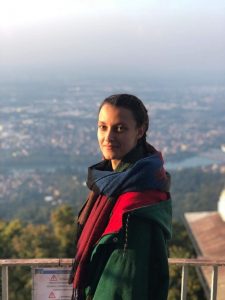 Olá, my name is Chloé and I am from France. After obtaining a bachelor´s degree in Physics I joined an Erasmus Mundus Master program in Materials science for which I studied in Germany (München) and in Italy (Torino). I carried out my master thesis at ALBA synchrotron, in Spain, on heterogenous catalysis focusing on the preparation and the characterization of the inverse catalyst Ceria nanoparticles obtained by Atomic Layer Deposition supported on Palladium, for CO oxidation. PIONEER is thus an excellent match for my academic background. This project also offers the multidisciplinary I have always been seeking and the international environment in which I like to work.
Olá, my name is Chloé and I am from France. After obtaining a bachelor´s degree in Physics I joined an Erasmus Mundus Master program in Materials science for which I studied in Germany (München) and in Italy (Torino). I carried out my master thesis at ALBA synchrotron, in Spain, on heterogenous catalysis focusing on the preparation and the characterization of the inverse catalyst Ceria nanoparticles obtained by Atomic Layer Deposition supported on Palladium, for CO oxidation. PIONEER is thus an excellent match for my academic background. This project also offers the multidisciplinary I have always been seeking and the international environment in which I like to work.
I am currently a PhD student at IST (Instituto Superior Técnico), in Lisboa, under the supervision of Professor Vasco Guerra and the co-supervision of Professor Timo Gans from the Dublin City University (DCU). My work is centred on the modelling of non-equilibrium plasma kinetics. More precisely, the aim of this thesis is to investigate the kinetics of CO2 containing plasmas. For this purpose, I am using a zero-dimensional kinetic model to describe low-pressure DC discharges in CO2, CO2-O2 and CO2-N2. In parallel with this modelling work, I will perform experiments at the University of York, in low- and atmospheric-pressure RF discharges.
| Overview |  |
| ESR: | 4 |
| Title: | Reaction mechanism for CO2-N2 low-temperature plasmas: the role played by O2 and N2 on the CO2 vibrational kinetics and dissociation |
| Home Institution: | Instituto Superior Técnico, Universidade de Lisboa (IST-IPFN) |
| 1st Supervisor: | Vasco Guerra |
| Host Institution: | Dublin City University (DCU) |
| 2nd Supervisor: | Timo Gans |
| Secondment: | University of Antwerp (UAntwerpen) | Defence: | April 14 2023 |
Abstract
Among the approaches currently explored to reduce the anthropogenic CO2 emissions and mitigate climate change, Carbon Capture and Utilization (CCU) using non-thermal plasmas (NTPs) seems very promising. CO2-containing discharges are thus intensively studied nowadays, both in terms of experimental work and modelling, to better understand the plasma kinetics and ideally achieve efficient dissociation of CO2. This work contributes to this endeavour by means of a theoretical, experimental and numerical investigation of CO2 dissociation in CO2-containing NTPs. In particular, an experimental characterization of CO2-N2 DC glow discharge using Fourier Transform InfraRed (FTIR) absorption spectroscopy as a main diagnostic was performed at the Laboratoire de Physique des Plasmas (LPP). In parallel, a 0D self-consistent model for CO2-N2 discharges was developed and includes the vibrational kinetics of the first 72 levels of CO2, 10 levels of CO and 59 levels of N2. A refinement of our reference oxygen chemistry set was carried out, motivated by the relevance of oxygen species in CO2 plasma kinetics, and was followed by the study of different CO2-O2 mixtures using the Lisbon KInetics (LoKI) numerical code. The major role played by CO(a3Πr) in the back reaction mechanism is responsible for the detrimental effect of O2 addition in the discharge. In addition, the importance of the CO2-O vibrational-translational (V-T) exchange on the description of the CO2 vibrational kinetics was revealed. This work ultimately led to the development of a reaction mechanism (i.e., set of reaction and rate coefficients validated against benchmark experiments) for CO2-N2 plasmas by comparing the simulation results with the experimental data measured at LPP. The beneficial effect of N2 addition on the CO2 dissociation CO2-N2 plasmas was explained by the dilution, limiting the back reactions and by the role of N2(B3Πg) further improving the dissociation. Finally, the CO2-N2 vibrational-vibrational (V-V) energy transfer is crucial for a proper description of the CO2 vibrational kinetics.
Links with other ESR
Secondments
- UoY: Measurements on APP’s
- UAntwerpen: Comparison of modeling approaches and numerical techniques

